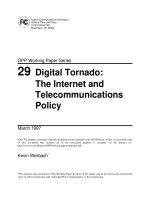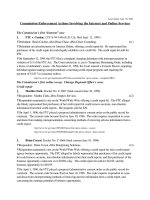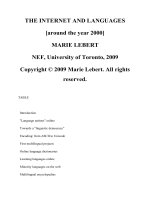infomation technology the internet and you chapter 12
Bạn đang xem bản rút gọn của tài liệu. Xem và tải ngay bản đầy đủ của tài liệu tại đây (2.28 MB, 20 trang )
Chapter
12
Systems Analysis and Design
Chapter 12
© 2017 by McGraw-Hill Education. This proprietary material solely for authorized instructor use. Not authorized for sale or distribution in any manner. This document may not be copied, scanned, duplicated, forwarded, distributed, or posted on a website, in whole or part.
Learning Objectives
Describe the six phases of the systems life cycle.
Identify information needs and formulate possible solutions.
Analyze existing information systems and evaluate the feasibility of alternative systems.
Identify, acquire, and test new system software and hardware.
Switch from an existing information system to a new one with minimal risk.
Perform system audits and periodic evaluations.
Describe prototyping and rapid applications development.
Computing Essentals 2017
1.
2.
3.
4.
5.
6.
7.
© 2017 by McGraw-Hill Education. This proprietary material solely for authorized instructor use. Not authorized for sale or distribution in any manner. This document may not be copied, scanned, duplicated, forwarded, distributed, or posted on a website, in whole or part.
Introduction
Most people in an organization are involved with an information system of some kind.
For the organization to create
and use the system requires
thought and effort.
In this chapter, you learn
about a six step process
for performing systems
Computing Essentals 2017
analysis and design.
© 2017 by McGraw-Hill Education. This proprietary material solely for authorized instructor use. Not authorized for sale or distribution in any manner. This document may not be copied, scanned, duplicated, forwarded, distributed, or posted on a website, in whole or part.
System Analysis and Design
A system is defined as a collection of activities and
elements organized to accomplish a goal
System Analysis and Design
Six-phase problem-solving procedure for examining and
Computing Essentals 2017
improving an information system
© 2017 by McGraw-Hill Education. This proprietary material solely for authorized instructor use. Not authorized for sale or distribution in any manner. This document may not be copied, scanned, duplicated, forwarded, distributed, or posted on a website, in whole or part.
Computing Essentals 2017
Six-Phase System Life Cycle
© 2017 by McGraw-Hill Education. This proprietary material solely for authorized instructor use. Not authorized for sale or distribution in any manner. This document may not be copied, scanned, duplicated, forwarded, distributed, or posted on a website, in whole or part.
Phase 1: Preliminary Investigation
The preliminary investigation determines
the need for a new information system
Define the problem
Suggest alternatives
Prepare report
Computing Essentals 2017
1.
2.
3.
© 2017 by McGraw-Hill Education. This proprietary material solely for authorized instructor use. Not authorized for sale or distribution in any manner. This document may not be copied, scanned, duplicated, forwarded, distributed, or posted on a website, in whole or part.
Phase 2: Systems Analysis
Data is collected about the present system and
then analyzed to determine the new requirements
Gather data
Analyze data
Create summary
Computing Essentals 2017
1.
2.
3.
© 2017 by McGraw-Hill Education. This proprietary material solely for authorized instructor use. Not authorized for sale or distribution in any manner. This document may not be copied, scanned, duplicated, forwarded, distributed, or posted on a website, in whole or part.
Analyzing the Data in Phase 2
Top-down analysis method is used to identify the top-level components of a
complex system and each component is broken down into small components
making analysis easier
Grid charts show the relationship between input and output documents
System flowcharts show the flow of input data to processing and finally to output or
distribution of information
Data flow diagrams show the data or information flow within an information system
Automated design tools
Documenting
Computer-aided software engineering tools (CASE)
Computing Essentals 2017
Systems Analyst Report
© 2017 by McGraw-Hill Education. This proprietary material solely for authorized instructor use. Not authorized for sale or distribution in any manner. This document may not be copied, scanned, duplicated, forwarded, distributed, or posted on a website, in whole or part.
Data Analysis Tools – Grid Chart
Computing Essentals 2017
Show the relationship between input and output documents
© 2017 by McGraw-Hill Education. This proprietary material solely for authorized instructor use. Not authorized for sale or distribution in any manner. This document may not be copied, scanned, duplicated, forwarded, distributed, or posted on a website, in whole or part.
Data Analysis Tools – System Flowchart
System flowcharts show the flow of
input data to processing and finally to
output or distribution of information.
System flowchart is to the left
System flowchart symbols are to the
Computing Essentals 2017
right
© 2017 by McGraw-Hill Education. This proprietary material solely for authorized instructor use. Not authorized for sale or distribution in any manner. This document may not be copied, scanned, duplicated, forwarded, distributed, or posted on a website, in whole or part.
Data Analysis Tools – Data Flow Diagram
Show the data or information flow within an information
system
Data is traced from its origin through processing,
storage, and output
Computing Essentals 2017
Top diagram shows data flow
Bottom diagram shows data flow symbols
© 2017 by McGraw-Hill Education. This proprietary material solely for authorized instructor use. Not authorized for sale or distribution in any manner. This document may not be copied, scanned, duplicated, forwarded, distributed, or posted on a website, in whole or part.
Phase 3: Systems Design
Three tasks
Define the alternatives
Select the best system
Write a systems design report
Evaluate systems according to:
Economic feasibility asks is a new system be
economical?
Technical feasibility asks is it technically possible?
Operational feasibility asks how it will be received by all
Computing Essentals 2017
users
© 2017 by McGraw-Hill Education. This proprietary material solely for authorized instructor use. Not authorized for sale or distribution in any manner. This document may not be copied, scanned, duplicated, forwarded, distributed, or posted on a website, in whole or part.
Phase 4: Systems Development
Three steps
Acquire the software
Acquire the hardware
Test the new system
Computing Essentals 2017
1.
2.
3.
© 2017 by McGraw-Hill Education. This proprietary material solely for authorized instructor use. Not authorized for sale or distribution in any manner. This document may not be copied, scanned, duplicated, forwarded, distributed, or posted on a website, in whole or part.
Phase 5: Systems Implementation or Conversion
Types of conversion
Computing Essentals 2017
Direct – out with the old and in with the new
Parallel – old and new systems operate side by side until
new system is reliable
Pilot – new system is tried by one section of the
organization, then another, etc.
Phased – new system is introduced a little at a time
© 2017 by McGraw-Hill Education. This proprietary material solely for authorized instructor use. Not authorized for sale or distribution in any manner. This document may not be copied, scanned, duplicated, forwarded, distributed, or posted on a website, in whole or part.
Phase 6: Systems Maintenance
Systems maintenance is an ongoing activity
Two Parts
Systems audit - system’s performance is
compared to the original design specs to
determine productivity
Periodic evaluation – all system’s should
Computing Essentals 2017
be evaluated time to time
© 2017 by McGraw-Hill Education. This proprietary material solely for authorized instructor use. Not authorized for sale or distribution in any manner. This document may not be copied, scanned, duplicated, forwarded, distributed, or posted on a website, in whole or part.
Prototyping and Rapid Applications Development
Alternatives to the systems life cycle
Computing Essentals 2017
Prototyping - building a model of the new system for trial
Rapid applications development (RAD) – costly but development is short and quality is better
© 2017 by McGraw-Hill Education. This proprietary material solely for authorized instructor use. Not authorized for sale or distribution in any manner. This document may not be copied, scanned, duplicated, forwarded, distributed, or posted on a website, in whole or part.
Careers in IT
A systems analyst plans and designs new systems, following the systems life cycle
Requires a Bachelor’s
degree in Computer
Science or Information
Systems
Technical experience
Can expect to earn an annual
Computing Essentals 2017
salary of $50,000 to $64,000
© 2017 by McGraw-Hill Education. This proprietary material solely for authorized instructor use. Not authorized for sale or distribution in any manner. This document may not be copied, scanned, duplicated, forwarded, distributed, or posted on a website, in whole or part.
A Look to the Future ~
The Challenge of Keeping Pace
To stay competitive with today’s fast
business pace, new technologies must be
incorporated
Increased use of RAD
and prototyping
Increased use of
Computing Essentals 2017
outside consulting
© 2017 by McGraw-Hill Education. This proprietary material solely for authorized instructor use. Not authorized for sale or distribution in any manner. This document may not be copied, scanned, duplicated, forwarded, distributed, or posted on a website, in whole or part.
Open-Ended Questions (Page 1 of 2)
1.
What are the tools used in the analysis phase? What is top-down analysis? How is it used?
Computing Essentals 2017
2.
What is a system? What are the six phases of the systems life cycle? Why do corporations undergo this
process?
© 2017 by McGraw-Hill Education. This proprietary material solely for authorized instructor use. Not authorized for sale or distribution in any manner. This document may not be copied, scanned, duplicated, forwarded, distributed, or posted on a website, in whole or part.
Computing Essentals 2017
Open-Ended Questions (Page 2 of 2)
3.
Describe each type of system conversion. Which is the most commonly used?
4.
What is system maintenance? When does it occur?
5.
Explain prototyping and RAD. When might they be used by corporations?
© 2017 by McGraw-Hill Education. This proprietary material solely for authorized instructor use. Not authorized for sale or distribution in any manner. This document may not be copied, scanned, duplicated, forwarded, distributed, or posted on a website, in whole or part.









